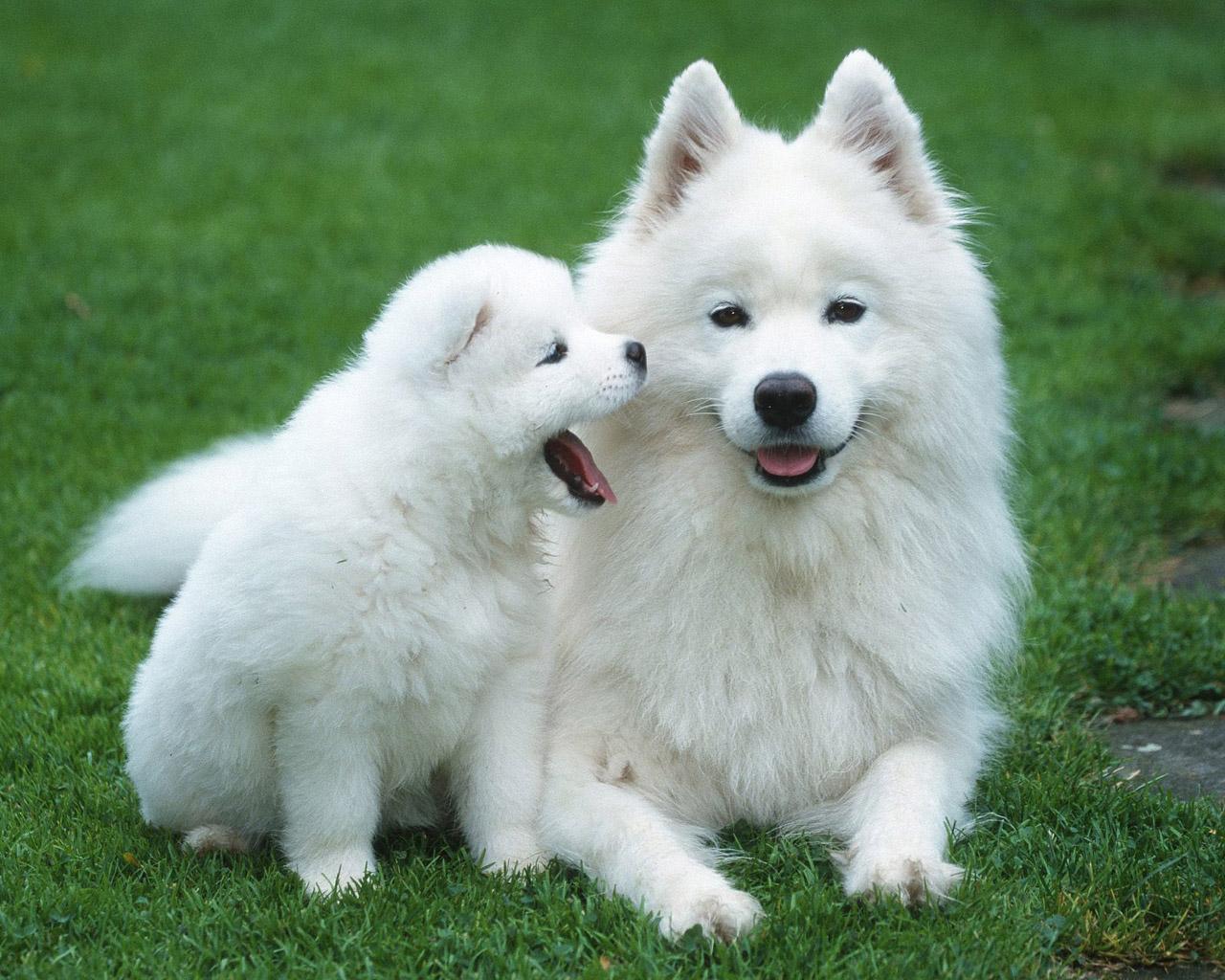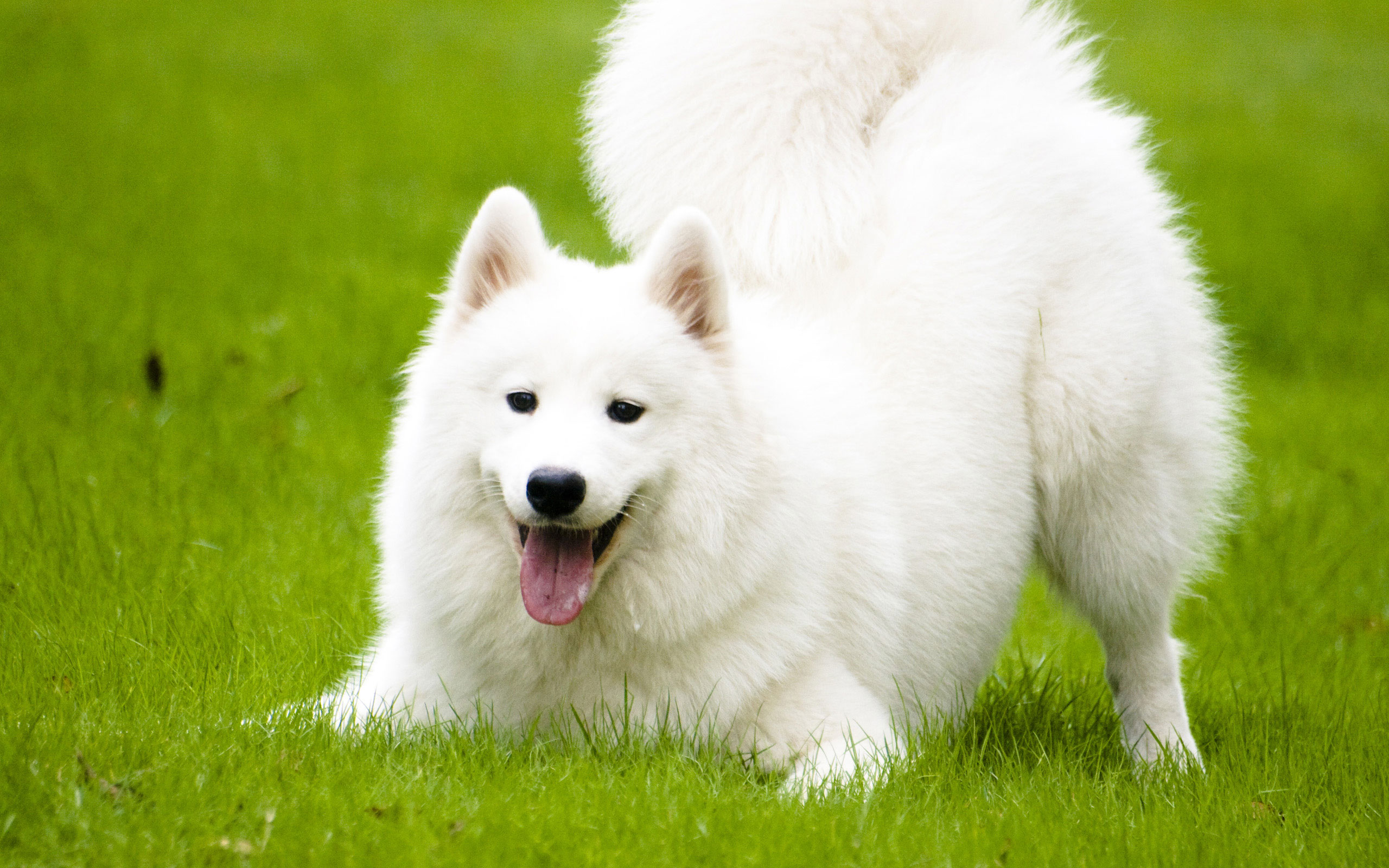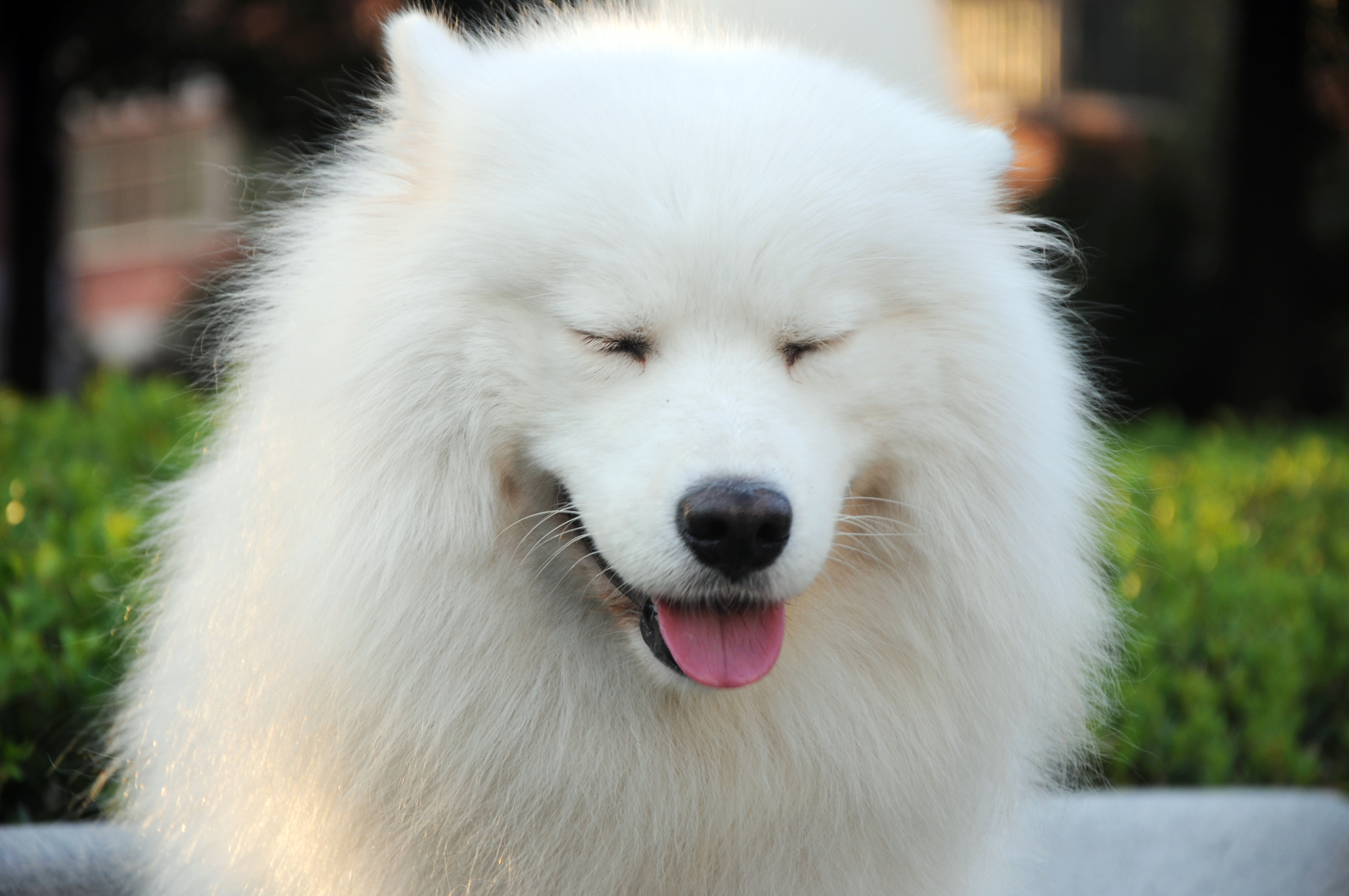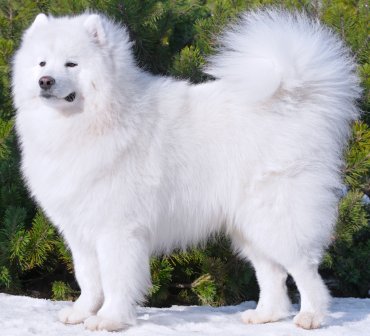
The Breed History
In ancient times, the early ancestral dogs of the Samoyed breed
likely moved with migrating tribes from Iran through Mongolia to
the Northwestern Siberian tundra. There they helped the Samoyede
people in many ways, and were welcomed as family members into
their nomadic dwellings. They were first brought to England in the
late nineteenth century. The first dog was registered with AKC in
1906.
Breeding for Function
These dogs provided herding and guarding for the reindeer herds,
and also were valued as close companions. They excelled as sled
dogs in many of the early Arctic and Antarctic expeditions.
Physical Characteristics
Height at Withers: female 19-21" (48-53 cm), male 21-23.5"
(53-60 cm).
Weight: 50-65 lb (23-29.5 kg).
Coat: The double coat is profuse, heavy and very resistant to the
elements. Males have a particularly well-developed lion's type
ruff. The undercoat is soft, short and wooly while outer hairs are
straight, stand out from the body and are glistening silvery-white.
Some dogs have a creamy or biscuit color.
Longevity: 12 years
Points of Conformation: The head is wedge-shaped, broad and
the muzzle is moderate in all aspects, with some tapering. The nose
is usually black (also liver and brown) and large. A well-defined
stop is present, and the black rimmed lips are characteristically
slightly upturned resulting in what breeders term the "Samoyed
smile". Ears have thick leather and stand erect, and are short and
triangular, though rounded at the tips. Eyes and palpebral rims
are darkly pigmented. Blue eyes disqualify. Almond shaped and
deep set, widely spaced, the eyes slant up laterally. Strong in bone
and musculature, the thorax is deep and ribs are well sprung.
The topline is highest at withers and straight. They possess a
moderate abdominal tuck up. The muscular neck is fairly short.
Limbs are moderate in length and straight boned. The feet are
large (hare-foot) with arched toes and thick pads, with thick hair
between the toes. Some feathering on the feet is often present. The
tail reaches the tarsus when held down, is profusely covered with
hair, and when moving or alert, should be over the back and to one
side. The proper gait is a trot, not a pace, and strides are quick and
agile; springiness and speed are valued.
Recognized Behavior Issues and Traits
Reported breed characteristics include: Loyal guardian of home
and family, not argumentative with other dogs generally, require
lots of exercise, playful, curious, high grooming needs, tend to pull
on leash; need early obedience training, gentle and intelligent but
with an independent streak. Good with children. Need close human
companionship, tolerate weather extremes well, particularly the
cold. If not mentally or physically active and challenged, or given
adequate time with family, they may become destructive. They have
a high pitched bark.
Normal Physiologic Variations
None Reported
Drug Sensitivities
Samoyeds are overrepresented in the population of dogs with
adverse reactions to potentiated sulfonamides. Clinical signs
included hypersensitivity, thrombocytopenia and hepatopathy, and
infrequently can include neutropenia, keratoconjunctivitis sicca,
hemolytic anemia, arthropathy, uveitis, skin and mucocutaneous
lesions, proteinuria, facial palsy, suspected meningitis,
hypothyroidism, pancreatitis, facial edema, and pneumonitis.
Inherited Diseases
Hip Dysplasia: Polygenically inherited trait causing degenerative
joint disease and hip arthritis. OFA reports 11.1% affected. Dorn
reports a 1.32x odds ratio versus other breeds. Reported at a
frequency of 24% in the 1999 SCA Health Survey.
Patella Luxation: Polygenically inherited laxity of patellar
ligaments, causing luxation, lameness, and later degenerative joint
disease. Treat surgically if causing clinical signs. Reported at a high
frequency by the OFA, but too few Samoyeds have been screened to
determine an accurate frequency.
Elbow Dysplasia: Polygenically inherited trait causing elbow
arthritis. OFA reports 2.3% affected.
X-linked Progressive Retinal Atrophy (XLPRA): X-linked recessive
degeneration of the retina. Causes blindness between 3-6 years of
age. Reported in 0.21% of Samoyeds CERF examined by veterinary
ophthalmologists between 1991-1999. A genetic test is available
through Optigen, that reports 1% of Samoyeds test as affected,
and 2% test as carriers. CERF does not recommend breeding any
Samoyed with PRA. Reported at a frequency of 2.4% in the 1999
SCA Health Survey.
Oculo-Skeletal Dysplasia (OSD): Autosomal recessive
developmental disease causing ocular vitreous dysplasia, cataracts,
retinal detachment, and dwarfism with valgus deformity of the
carpi. Heterozygous carriers of the defective gene present with
various forms of retinal dysplasia. CERF does not recommend
breeding any affected Samoyeds. A genetic test for RD/OSD is
available.
Retinal Dysplasia (RD): Retinal dysplasia can be due to the
incompletely dominant expression of the heterozygous form of the
gene for oculo-skeletal dysplasia, though not all Samoyeds with
retinal dysplasia are due to this testable gene. Focal retinal dysplasia
and retinal folds can progress to retinal detachment. Reported in
2.24% of Samoyeds CERF examined by veterinary ophthalmologists
between 2000-2005. CERF does not recommend breeding
any Samoyed with retinal dysplasia. A genetic test for RD/OSD is
available.
Hereditary Nephritis (glomerulopathy): X-linked dominant
inherited kidney disease. Affected males develop kidney disease
from 3-5 months of age, and succumb to kidney failure by 15
months of age. Affected females have a less severe form of kidney
disease that does not progress to failure. This disorder may no
longer be present in the Samoyed breeding/pet population.
Disease Predispositions
Hypothyroidism: Inherited autoimmune thyroiditis. 9.0% positive
for thyroid autoantibodies based on testing at Michigan State
University. (Ave. for all breeds is 7.5%). Reported at a frequency of
8% in the 1999 SCA Health Survey.
Distichiasis: Abnormally placed eyelashes that irritate the cornea
and conjunctiva. Can cause secondary corneal ulceration. Dorn
reports a 1.19x odds ratio versus other breeds. Identified in 4.69%
of Samoyeds CERF examined by veterinary ophthalmologists
between 2000-2005.
Diabetes Mellitus (Sugar Diabetes): Samoyeds have an inherited
form of DM with an average age of onset of 7 years (range 4-10
years). Caused by immune-mediatd destruction of insulin producing
beta cells of the pancreas. Research shows relationship to certain
major histocompatability (MHC) genes, and mutations in the CTLAY
promotor gene. Control by insulin injections, diet, and glucose
monitoring. Odds ratios versus other breeds reported as 7.58x
(Dorn), 11.83x (Hess), to 21.7x (Catchpole). Unknown mode of
inheritance. Reported at a frequency of 4% in the 1999 SCA Health
Survey.
Corneal Dystrophy: The breed can form epithelial corneal
opacities that do not lead to corneal edema. Identified in 2.51% of
Samoyeds CERF examined by veterinary ophthalmologists between
2000-2005.
Cataracts: Anterior or posterior punctate cataracts predominate
in the breed. Juvenile cataracts are also seen, with an onset of
6 months to 2 years of age. Cataracts are identified in 2.40% of
Samoyeds CERF examined by veterinary ophthalmologists between
2000-2005. Reported at a frequency of 7% in the 1999 SCA Health
Survey. CERF does not recommend breeding any Samoyed with a
cataract.
Gastric Dilation/Volvulus (GDV, Bloat): Life-threatening twisting
of the stomach within the abdomen. Requires immediate veterinary
attention. Samoyeds are at increased risk. Reported at a frequency
of 4.2% in the 1999 SCA Health Survey.
Persistent Pupillary Membranes: Strands of fetal remnant
connecting; iris to iris, cornea, lens, or involving sheets of tissue. The
later three forms can impair vision, and dogs affected with these
forms should not be bred. Identified in 2.29% of Samoyeds CERF
examined by veterinary ophthalmologists between 2000-2005.
Pulmonic Valve Stenosis: Samoyeds are a breed at increased risk
(5.4x odds ratio) for this congenital heart anomaly. Clinical signs
can include exercise intolerance, stunting, dyspnea, syncope and
ascites, leading to heart failure. Screen with auscultation and
echocardiography.
Primary (Narrow Angle) Glaucoma: Ocular condition causing
increased pressure within the eyeball, and secondary blindness due
to damage to the retina. Diagnose with tonometry and gonioscopy.
Reported at a frequency of 1.59% in the breed, with a female
preponderance. Dorn reports a 1.76x odds ratio versus other
breeds. CERF does not recommend breeding any Samoyed with
glaucoma.
Uveodermatologic (VKH-Like) Syndrome: This is an autoimmune
disease manifested by progressive uveitis and depigmenting
dermatitis that closely resembles the human Vogt - Koyanagi -
Harada syndrome. The disease presents between 1-1/2 to 4 years of
age, and can progress to blindness. Treatment is with steroids. CERF
does not recommend breeding any affected Samoyeds.
Alopecia-X (Black Skin Disease, BSD, Coat Funk): Progressive,
symmetrical, non-pruritic, truncal hair loss usually beginning in
early adulthood. ACTH, LDDS, and thyroid panel results are normal.
Oral trilostane reverses the condition in some cases. The disorder
appears familial.
Sebaceous Adenitis: Disorder of immune mediated sebaceous
gland destruction, presenting with hair loss, usually beginning
with the dorsal midline and ears. Diagnosis by skin biopsy. Treat
with isotretinoin. An autosomal recessive mode of inheritance is
suspected.
Lingual Squamous Cell Carcinoma (SCC): Samoyeds have a
24.63x odds ratio versus other breeds of developing this tongue
cancer. Females are overrepresented in one study.
Atrial Septal Defect, Cerebellar Abiotrophy, Deafness, Factor
VIII Deficiency, Growth Hormone Responsive Dermatosis,
Mcrophthalmia, Muscular Dystrophy, Myasthenia Gravis,
Osteochondritis Dessicans-Stifle, Oligodontia, Pelger-Huet
Anomaly, Shaker Syndrome, Spina Bifida, Spongiform
Leukodystrophy, Subaortic Stenosis, Ulcerative Keratitis,
Ventricular Septal Defect, von Willebrand's Disease, and Zinc
Responsive Dermatosis are reported.
Isolated Case Studies
Tremors and Hypomyelination: Reported in several related litters
of Samoyed pups. Clinical signs of tremors and an inability to stand occurred from 3-5 weeks of age. There was a lack of myelin in the
central nervous system due to abnormal oligodendrocyte function.
Genetic Tests
Tests of Genotype: Direct tests for XLPRA and RD/OSD are available
from Optigen.
Tests of Phenotype: CHIC Certification: Required tests are;
cardiac exam, CERF eye examination (minimum of 1 year of age),
hip dysplasia radiograph, and DNA test for XLPRA. (See CHIC
website: caninehealthinfo.org)
Recommended tests are; elbow radiographs, thyroid profile
including autoantibodies, and patella evaluation.
Miscellaneous
- Breed name synonyms: Samoyedskaya, Sammies (nickname).
- Registries: AKC, UKC, CKC, KCGB (Kennel Club of Great Britain),
ANKC (Australian National Kennel Club), NKC (National Kennel Club).
- AKC rank (year 2008): 73 (1,077 dogs registered)
- Internet resources: The Samoyed Club of America:
samoyedclubofamerica.org
Samoyed Association of Canada: samoyed.ca
The British Samoyed Club: british-samoyed-club.co.uk
Samoyed Club of America Research Foundation:
samoyedhealthfoundation.org
Photo Gallery of Breed - Samoyed - Dog Breed








 Animalia Life
Animalia Life